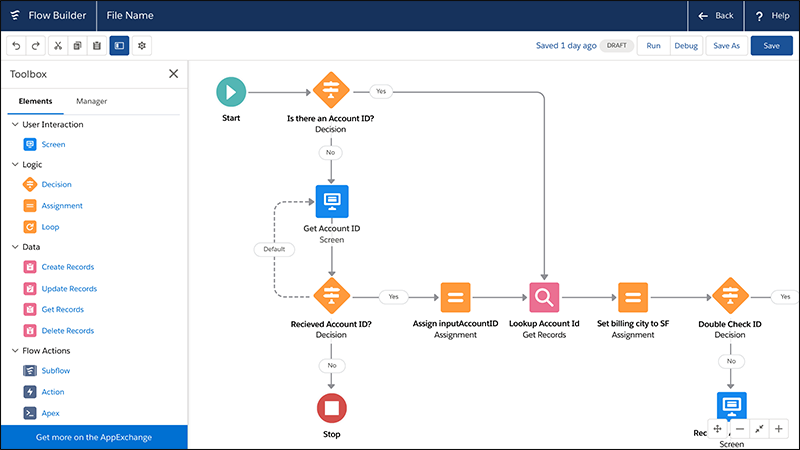Recommended Ideas To Selecting Low-code platforms for application development
Wiki Article
Benefits Of Low-Code Application Development In Terms Of Accessibility For Non-Developers
Due to a number of factors due to a variety of factors, low-code development is easier to non-developers. These are often called "citizens developers."
Drag-and Drop Builders: Low code platforms have drag-and drop interfaces that allow non-developers to develop applications without needing to write any code. This makes the process of developing easier for those with no technical backgrounds.
WYSIWYG: WYSIWYG editors are "What you see is what you Get" editors that permit users to create workflows and interfaces in a similar manner to the final product. It makes it much easier to comprehend and use.
Simplified Design of Workflow Logic and Workflow:
Visual Workflow Modeling - Users can create business processes and logic applications by using visual flowcharts or models. This is much more efficient than traditional programming techniques.
Logical Components Pre-built: Many low-code platforms come with already-built logic components (e.g. loops, conditions) which can be easily configured. This means that there is no requirement to write complex programs.
Reusable templates and components:
Library of Templates pre-built: Many platforms that offer low-code have a library of template types for the most common applications. This lets developers get started quickly and easily and non-developers to modify the templates as they see appropriate.
Reusable Modules and Widgets By using modular and widgets that can be reused, users can speed up the creation process and reduce the requirement for technical knowledge.
Guided Development Tutorials and Guided Development:
Step-by-Step Guides: Platforms usually offer a set of development guides, tutorials, and on-screen guidelines to assist novice developers in building applications.
Interactive Tutorials - Interactive tutorials which let you engage with the platform will aid in learning and increase confidence.
Integration of existing tools:
Easy Integration: Low-code platforms are designed to be easily integrated with existing tools for business and systems (e.g. CRM, ERP and ERP) and allow non-programmers to create applications that work within their current workflows.
APIs Connectors: APIs integrate into apps to facilitate integration. This allows non-programmers who don't have programming abilities, to connect to external services.
Collaboration Features:
Team Collaboration: Features like real-time collaborative workspaces and shared workspaces make it feasible for non-developers to work effectively with developers, business analyst and other key stakeholders.
Access Control Based On Roles: Developers who are not developers are able to have access to roles and levels of access that permit their participation without compromising security or functionality.
Automated Testing and Debugging
Built-in Testing Tools: Platforms that are low-code often have built-in testing tools and debugging tools that can automate these processes, making it easier for non-developers to make sure their applications work correctly.
Platform highlights errors when they happen and suggests solutions. This assists non-developers in problems.
The ability of low-code applications to make development accessible for those who are not developers is its main benefit. Through providing clear, intuitive tools and guided experiences low-code applications allow users of business to participate actively in developing and maintaining applications, which bridges the gap between requirements of business and the technical implementation. View the top rated Low-code Platform for application development for website examples including microsoft azure sql, low code development platforms, stored sql procedures, develop web application, stored sql procedures, paas service, cross platform mobile dev, mobile development platforms, driver jdbc, microsoft azure sql and more.

Benefits Of Low-Code Application Development In Terms Of Scalability, And Flexibility
Low-code application creation offers several advantages, specifically in terms of scaling. It is crucial to create applications that grow with your business and be able to adapt as the business grows. These are the major advantages: Rapid Scaling
Cloud-based Deployment : Many low code platforms are cloud based. This allows applications to scale seamlessly along with the cloud infrastructure. Businesses can handle greater load without having to worry too much about server administration.
Auto-Scaling Features: Auto-scaling functions built-in can automatically adjust resources according to demand, ensuring the same performance even during peak hours without the need for manual intervention.
Flexible Architecture:
Modular Application Design: A low-code platform allows for modular design of application. Components can be independent tested, developed and increased in size. Modularity is an excellent method to improve flexibility. It is also easy to modify and expand the functionality of an application without having to have the entire application affected.
Microservices Architecture: The Microservices architecture allows the creation of applications by creating a loosely coupled set of services. This improves capacity and flexibility.
Customizable Solutions:
Extensibility: Low-code platforms usually permit custom programming and scripting, enabling developers to expand the capabilities of the application beyond what is already available. This allows the fulfilment of specific business requirements without restrictions.
Integration with Third-Party Integrations: Integration of third-party APIs and services allows companies to add more functionality to their application.
Agile Development and Deployment
Continuous Delivery & Deployment Low-code Platforms facilitate agile methods through enabling continuous integration and Continuous Delivery (CI/CD). This facilitates rapid deployment of features and updates. The applications can evolve rapidly as a result of market trends and user feedback.
Iterative Development: Because of the iterative nature, low-code applications can scale and grow incrementally. This reduces the risks associated with major changes and allows for greater control over expansion.
Resource Optimization
Effective Resource Management: Low-code systems assist maximize the use of resources by offering tools for monitoring and managing the performance of applications. This will ensure that resources are utilized effectively. They can also be scaled-up or reduced in accordance with the actual requirements.
Load Balancing: The integrated load balancing feature distributes workloads equally across servers. This increases the application's capacity to handle high traffic, and ensures constant performance.
Global Reach:
Multi-Region deployment: Low-code systems can often support deployment across multiple regions. This allows companies to offer low-latency service to users around the world. This is crucial when it comes to applications that target users from all over the world.
Localization Support The built-in support for language localization allows applications to be easily adapted for different languages and regional requirements, enhancing their flexibility in various markets.
Maintenance and Updates
Maintenance is easy: The modularity and appearance of low-code applications makes maintenance easier, allowing for quick fixes and updates to be implemented without lengthy downtime.
Version Control Version Control: Systems that integrate version control handle rollbacks and changes to ensure that updates are safe to be deployed and that previous versions can restored if necessary.
Cost Efficiency:
Low Development Costs: By decreasing the amount of programming needed, low-code platforms can cut down on the development cost. This makes it possible to expand applications without increasing the development effort and expenditure.
Pay-As.-You-Go A lot of lowcode platforms have flexible pricing models, such as pay-as.-you-go. These models align costs to actual usage and growth to provide financial flexibility.
In general, low-code development offers businesses the flexibility and scalability that they require to create robust and adaptable applications. These platforms provide quick responses to changing requirements, resource efficiency, and continuous improvements, allowing for applications to grow with a business. Have a look at the recommended continue reading this on Legacy application modernization with Low-code for site recommendations including application development platforms, application modernisation, paas service, low code platforms, application development platforms, application modernisation, azure sql, mobile app development platforms, rapid app development, rapid action development and more.

Benefits Of Low Code Application Development In Terms Of Limitations And Customization
Low-code is an approach that is balanced and allows for substantial customization and overcomes weaknesses. Here are a few principal benefits: Handling limitations:
Removing Complexity Barriers
Low-code platforms facilitate development by providing pre-built templates and other components. This allows faster deployment and the development of more complex applications.
Guided Workflows - Many platforms offer guided workflows or wizards that help developers navigate complex procedures. This decreases the possibility of error and ensures the sameness of the process.
Scalability Solutions:
Scalability Built-In: Lowcode platforms usually include features to allow for the scalable architecture. They allow applications to handle growing loads without major changes.
Performance Monitoring Tools: Instruments for monitoring and enhancing performance are incorporated in the application to ensure that it is efficient, regardless of the size.
Security and Compliance
Integrated Security Features: Low code platforms come with security features that are built in including encryption and access control based on role. They also run automated checks for compliance to address security concerns.
Platforms are constantly updating their security protocols and ensure that they are in compliance with the regulatory requirements. This helps keep applications safe from emerging threats.
Customization Capabilities:
Extensibility:
Custom Code Integration: Low-code systems usually permit the integration of custom code (e.g., JavaScript, Python), enabling developers to enhance the functionality beyond the basic features.
Custom Modules and plugins: Developers have the option to create customized modules or plugins to modify specific functionality to meet specific business requirements.
APIs and integration:
API Support. Comprehensive API support allows seamless integration with external systems and services, allowing extensive customization and connection.
Third-Party services: Low code platforms provide connectors that are built for popular third party services. This makes it much easier to customize and integrate applications.
Flexible Design for UI/UX
Customizable user interfaces: Developers can modify and design user interfaces to fulfill specific branding requirements as well as requirements for usability, resulting in an experience that is customized for users.
Responsive Designs: The applications can be customized to suit different sizes of screens and devices.
Business Logic Customization:
Visual Workflow Designers: These tools can be used to customize and design workflows as well as business logic, allowing programmers to design complex processes that are tailored for their needs.
Conditional Logic and scripting: Platforms allow the integration of conditional logic and custom scripting that can handle certain business rules and scenarios.
Data Management:
Custom Data Models: Developers are able to develop custom data models that fit specific needs of the application, ensuring that data handling is customized to the business needs.
Advanced Data Processing: The integration with the latest tools and capabilities for data processing allows for customization in the way that data is analysed and utilized within the application.
Balancing limitations with customisation:
Frameworks & Standards
Low-code Platforms Encourage Industry Best practices and standards: Low code platforms encourage adherence to industry-standard best practices and standards. This helps to maintain high-quality, secure and scalable applications.
Governance Frameworks. Built-in frameworks of governance ensure that customizations will not compromise the security, compliance or integrity of the application.
Iterative Development and Feedback:
Rapid prototyping: Being capable of rapidly prototyping and test customizations, developers are able to iterate on user feedback to improve the application.
Low-code platforms facilitate continuous improvement, allowing for continuous customization and further enhancing the platform as requirements of business evolve.
User Empowerment
Low-code platforms allow citizen developers to develop by allowing non-developers with intuitive interfaces, to personalize applications, they increase the pool contributors that can enhance and tailor apps.
Training and Support: Many platforms have extensive resources for training and support to assist users with making efficient customizations without compromising the stability of the application or performance.
Low-code software provides a scalable framework that can be tailored to meet the specific requirements. This allows companies to create and maintain functional apps tailored to their needs while ensuring high standards of quality, security and scaling.
